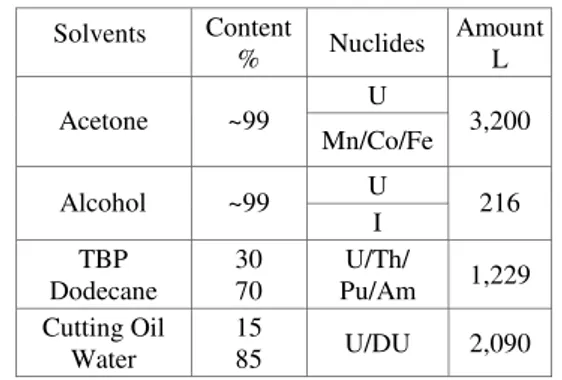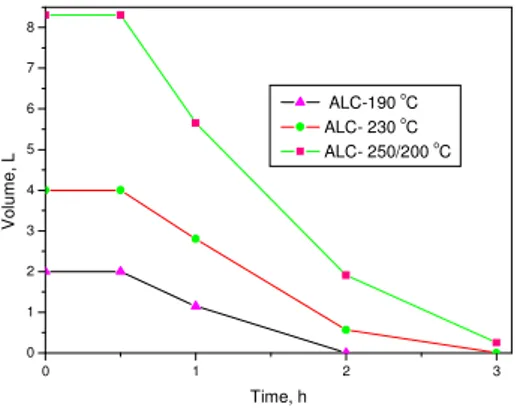Treatment of Organic Radioactive Wastes by Evaporation
Utilizing DU Oxidation Apparatus
Kil J. Kim, Il Sik Kang, Jong S. Shon, and Kwon P. Hong
Division of Nuclear Fuel Cycle Examination Facility, Korea Atomic Energy Research Institute
1. Introduction
Organic radioactive liquid wastes of various kinds are generated from nuclear fuel cycles, research laboratories in Korea Atomic Energy Research Institute (KAERI). A strategy for the effective treatment of these wastes is needed in order to make sure of safe disposal, because organic radioactive wastes require their radioactivity and also chemical content, and both have detrimental effects on health and the environment.
Those organic radioactive wastes typically include solvents from extraction research, uranium refining and conversion, lubricating oil, scintillation cocktails from laboratories and other solvents from the decontamination of equipment.
Several techniques conditioning organic radioactive wastes have been developed. Incineration is an attractive technique for treating organic liquid wastes because those are readily combustible and give high volume reduction(1), but the combustion produces corrosive products in combination with water. Wet oxidation is a technique for breaking down TBP and organic acids to carbon dioxide and water with hydrogen peroxide in the presence of a catalyst at 100 o
C,(2) which is not simple to treat a large amount of solvents. Distillation of scintillation fluid has been practiced in the USA to recover solvents(3).
Evaporation technique is adopted in this study for a final disposal of major organic wastes, such as solvents from the decontamination of equipment and extraction process, and contaminated cutting oil, utilizing established facilities and ventilation system without a condensation of vaporized solvents.
The report describes characteristics of those wastes, effects of temperature and amount of solvents on evaporation, and the time needed for the complete evaporation using the corresponding pure solvents.
2. Experimental Methods 2.1 Reagents
Chemicals and apparatus used in the experiment are as follows :
- Chemicals : Extra pure grade of solvents, such as acetone, alcohol, TBP, and dodecane are used.
- Apparatus : DU oxidation equipment(4) and ventilation system with HEPA filter are utilized to directly remove vaporized solvents.
N2 and CO2 gas-charging system is added for controlling the temperature inside the apparatus against an unexpected rising of the temperature.
The experiments were carried out using the main heater on the bottom for small amounts of solvents and main heater with surround heater on the wall for 8 l of solvent, where the solvent is placed in two different layers. Effect of the amount of each solvent, and evaporation temperature on the removal of solvents were checked and reviewed.
3. Results
3.1 Characteristics of Organic Radioactive Wastes
The composition of organic wastes are investigated and presented in Table1. Major solvents are acetone and alcohol from a decontamination of equipment, the mixture of TBP and dodecane from uranium extraction, and cutting oil from uranium fabrication, and these wastes account for the most of the stored organic wastes.
Table 1 Major Composition and Radionuclides of Organic Wastes stored in KAERI
Solvents Content % Nuclides Amount L U Acetone ~99 Mn/Co/Fe 3,200 U Alcohol ~99 I 216 TBP Dodecane 30 70 U/Th/ Pu/Am 1,229 Cutting Oil Water 15 85 U/DU 2,090
TBP and dodecane, and acetone wastes show quite high uranium concentrations, while activities are rather low.
Table 2 Uranium Concentration and Radioactivity in various Organic Wastes Solution
U Concentration µg/ml
Gross-α Bq/ml Solvent
Before After* Before After* TBP/ Dodecane 3,300 1,960 9.67 30.23 Acetone (Refinement) 4.2 62 0.53 0.43 Acetone (Fabrication) 1,100 24 10.0 0.4 Cutting Oil 224 47 1.29 0.36
* Values after absorption by IRN-77 resins
Transactions of the Korean Nuclear Society Autumn Meeting Busan, Korea, October 27-28, 2005
3.2 Evaluation of Evaporation Time depending
on the different Amount from each Solvent
Evaporation temperature is adapted considering boiling point of each solvent. In the case of acetone (Fig.1), there were not much differences in the evaporation time with increasing temperature and amount of acetone, and the whole evaporation were completed within two and half hours for the amount of 8 L. 0.5 1.0 1.5 2.0 2.5 0 1 2 3 4 5 6 7 8 V o lu m e , L Time, h 120 o C 120 o C 150 oC 170 o C
Fig. 1 Evaporation Time of Acetone with different Amounts and Temperature
For alcohol, a little higher temperature is applied due to higher b.p. than acetone(Fig.2). Evaporation could be also completed within 3 hours for 8 L of acetone.
0 1 2 3 0 1 2 3 4 5 6 7 8 ALC-190 o C ALC- 230 o C ALC- 250/200 o C V o lu m e , L Time, h
Fig. 2 Evaporation Time of Alcohol with different Amounts and Temperature
While, evaporation for the mixture of TBP and dodecane was very slow compared with the case of acetone and alcohol (Fig.3), which is considered to be due to the high b.p. of 289 oC for TBP and 216 oC for dodecane, and the whole evaporation took above 14 hours for 8 L of the mixture. Besides, the heating temperature was limited below 200 oC to exclude any possible spontaneous ignition by the vapor in higher temperature than 200 oC.
In the case of cutting oil(Fig.4), the similar results with TBP/dodecane were obtained taking almost 10 hours for the amount of 8 L.
0 1 2 3 4 5 6 7 8 9 10 11 12 13 14 15 0 1 2 3 4 5 6 7 8 V o lu m e , L Time, h TD-200/100 o C TD-200/200 o C TD-200/200 o C
Fig. 3 Evaporation Time for TBP/Dodecane with different Amounts and Temperature
0 1 2 3 4 5 6 7 8 9 10 0 1 2 3 4 5 6 7 8 V o lu m e , L Time, h CO-250o C CO-250oC CO-250/200o C
Fig. 4 Evaporation Time for Cutting Oil with different Amounts and Temperature
4. Conclusion
It is concluded from the results that the simple evaporation and the direct removal of vapor is sufficiently applicable finally to dispose of those organic wastes having lower boiling point within a relatively short time. For those having relatively higher boiling point, the evaporation is adoptable, but is not appeared to be most effective in the viewpoint of evaporation time.
REFERENCES
[1] Dirks, F., Hempelmann, W., “The Incineration Plant of the Karlsruhe Nuc. Resea. Cent.”, Incineration of Radioactive Waste(Proc. CEC Sem. Arnhem, 1984), Rep. CEC-EUR-9621, Graham and Trotman, London, 34-47(1985).
[2] Wilks, J.P., Holt, N.S., Wet Oxidation of Mixed Organic and Inorganic Radioactive Sludge Wastes from a Water Reactor, Waste Management 10, 197-203(1990).
[3] Delamano, J.C., Distillation as a Pretreatment Process of Waste Scintillation Solutions, Radiosctive Waste Management 2, BNES, London(1989).
[4] Kang, K.H., Kim, K.J., Oxidation Behavior of U-10% Zr Alloy in Air at 300-500 oC, Korean J. of Chem.Eng.,15(4),

